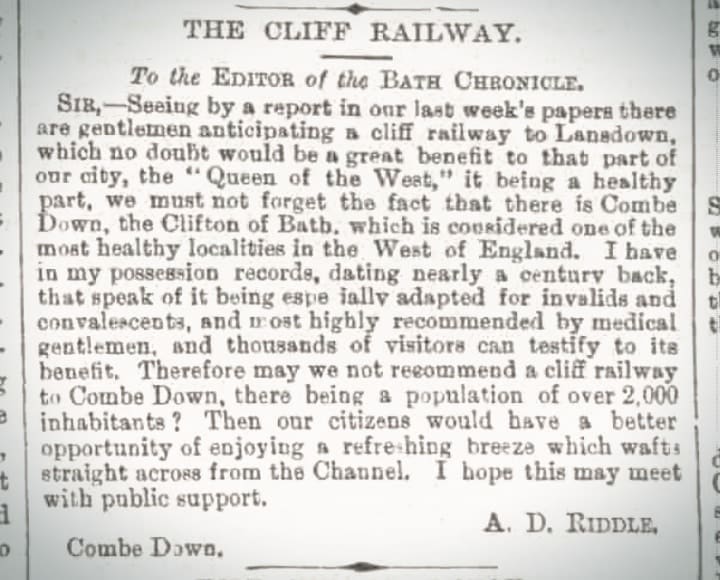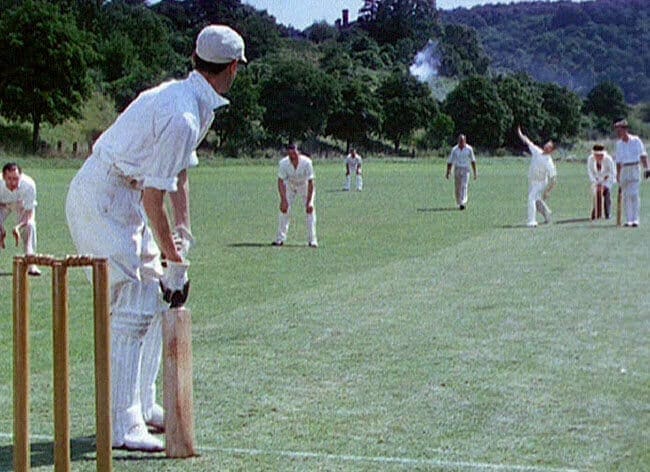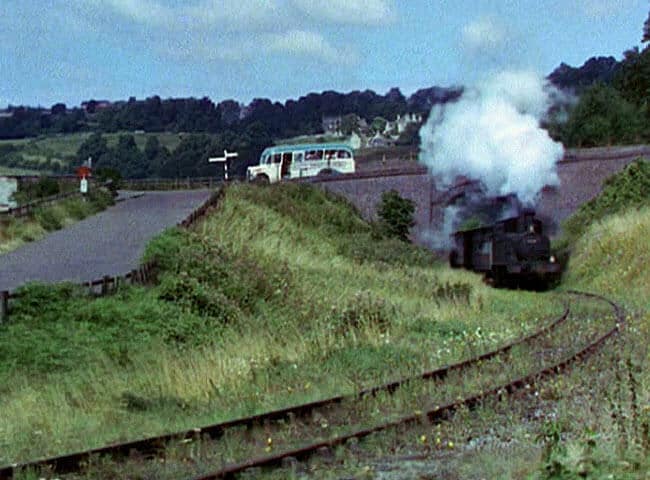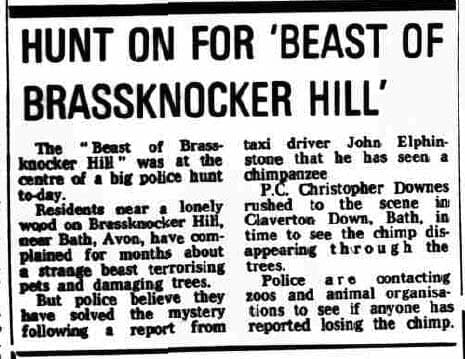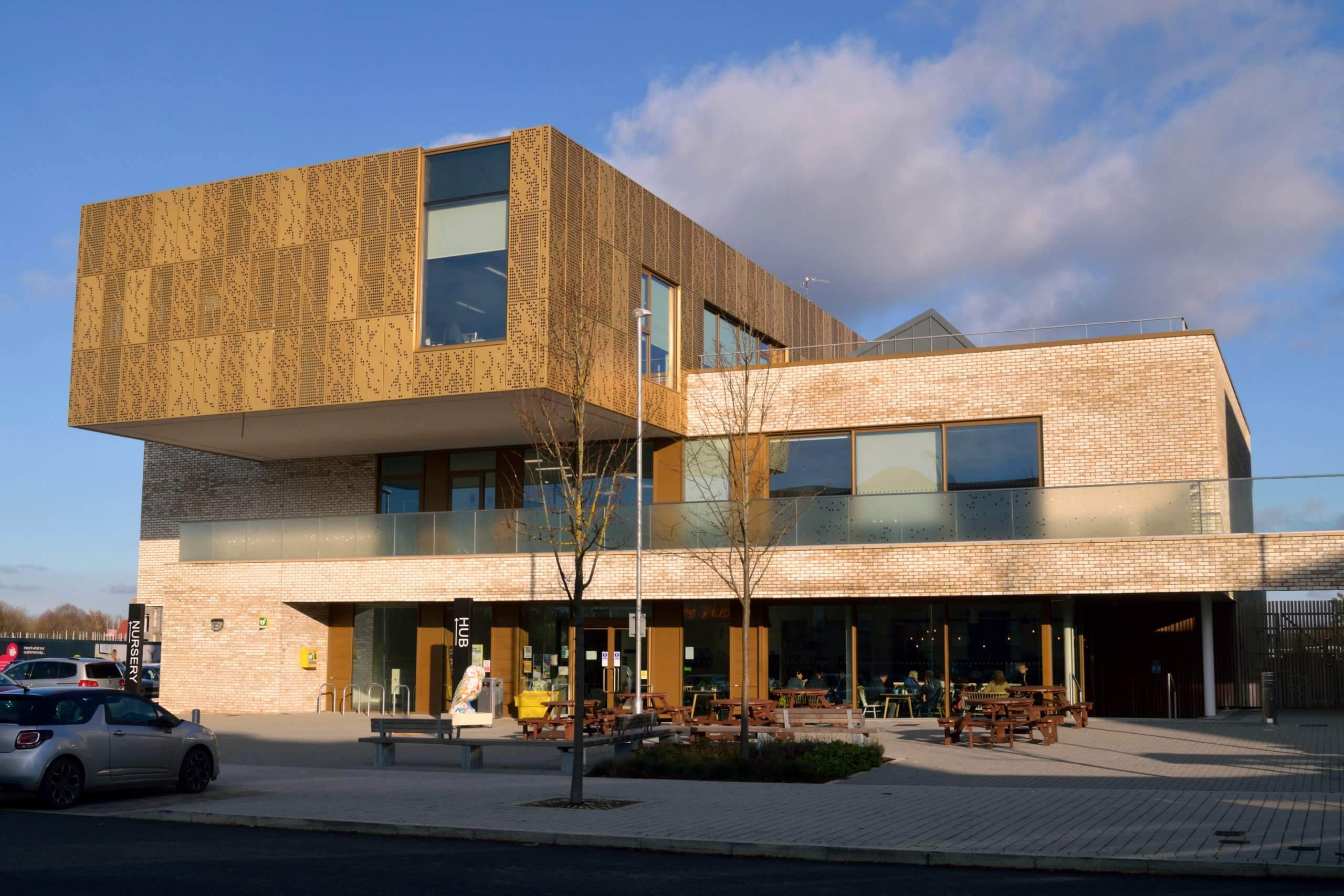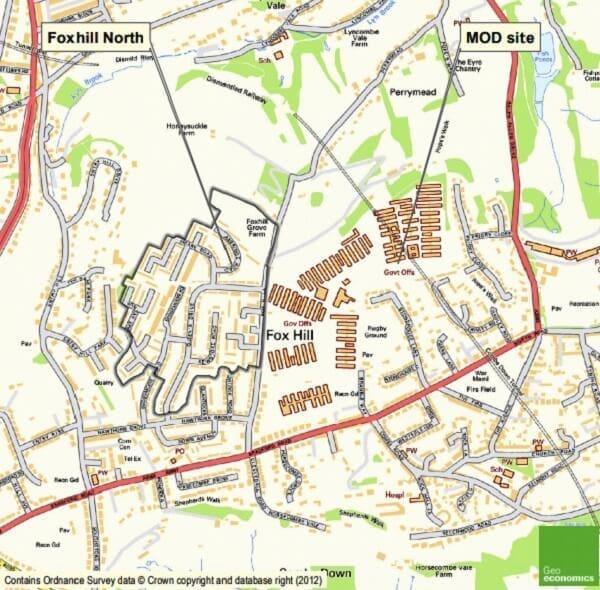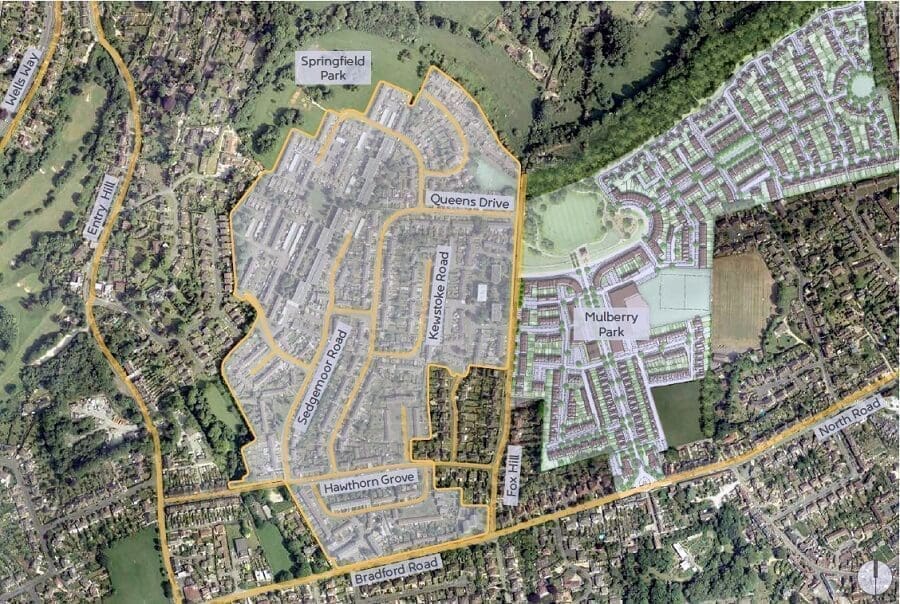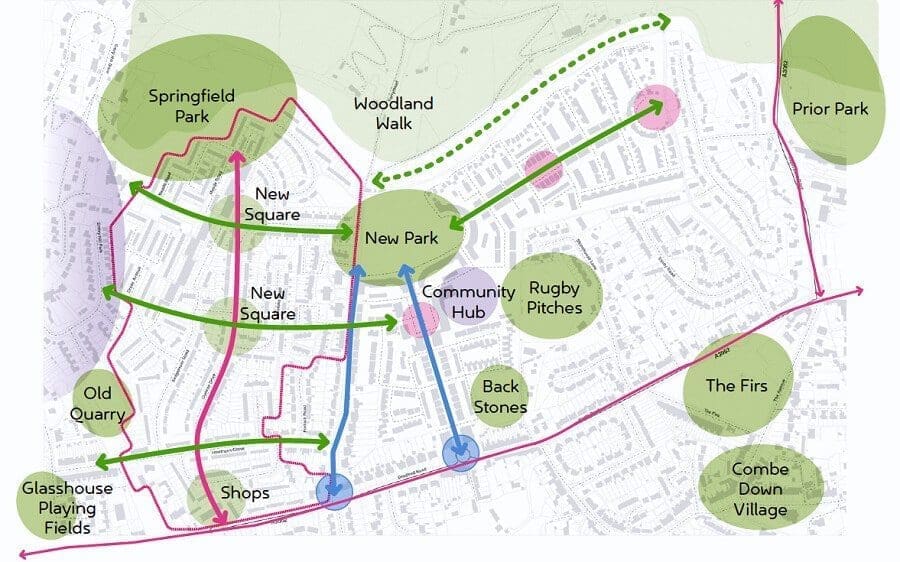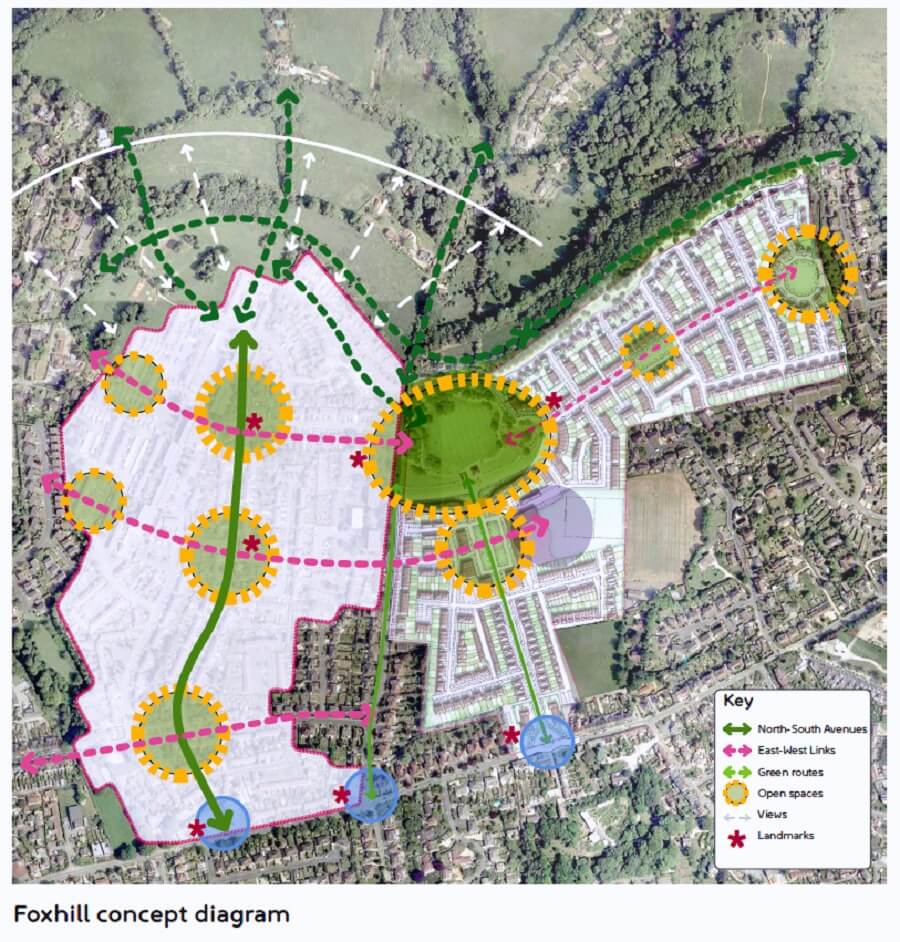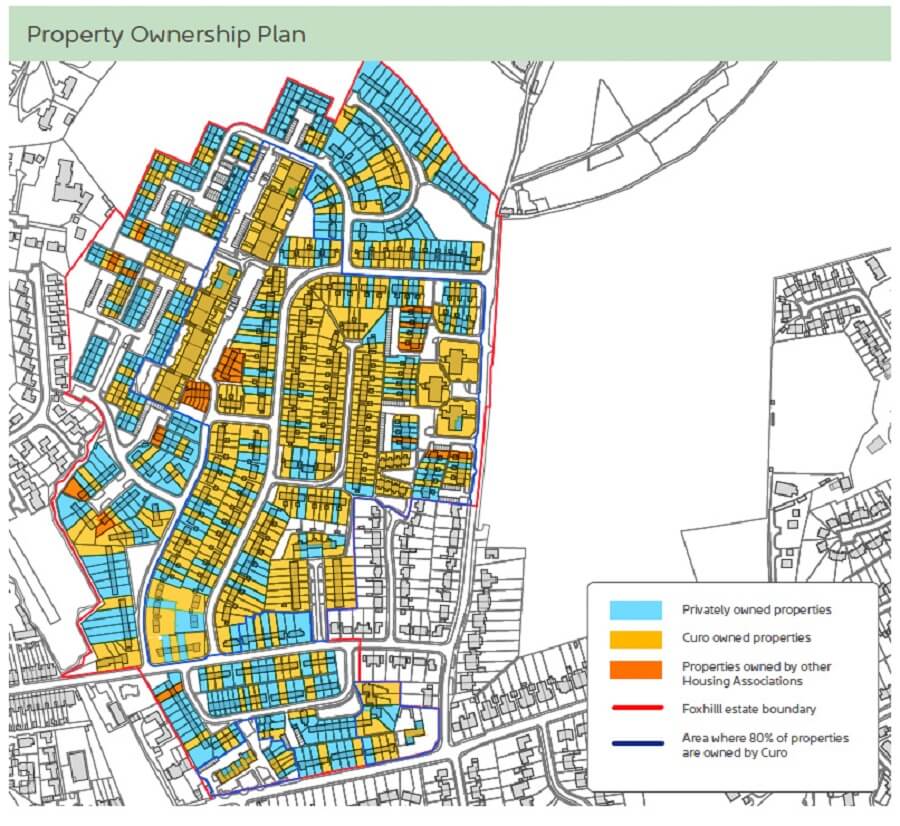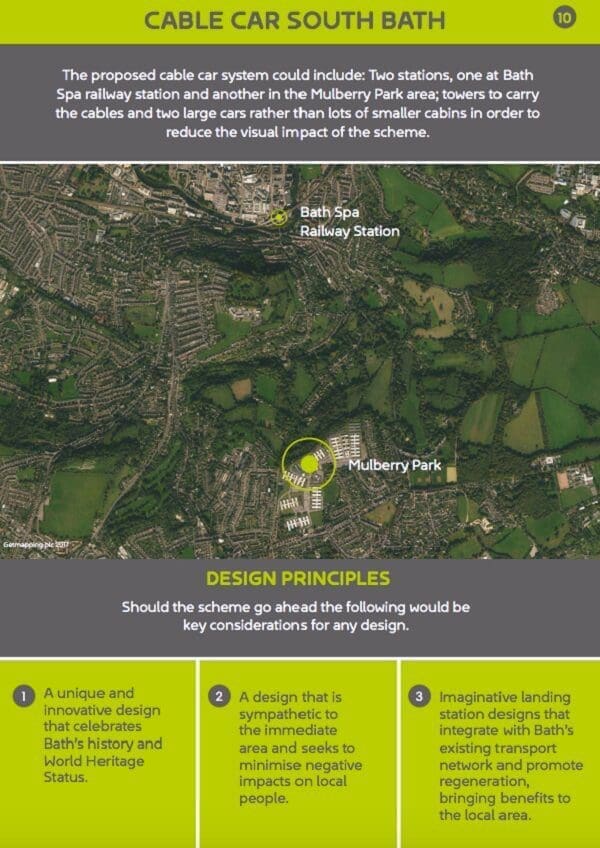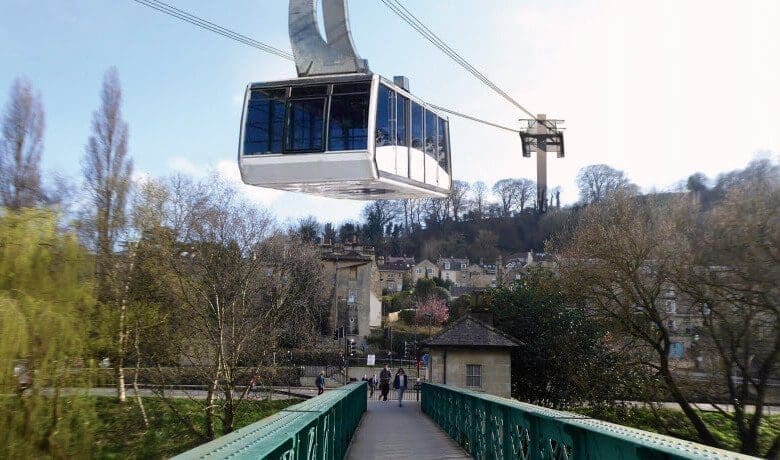The Titfield Thunderbolt
The Titfield Thunderbolt is a 1952 Ealing Studios film about a group of villagers trying to keep their branch line operating after British Transport Commission decided to close it. They decide to run the line themselves in competition with the replacement bus service.
After speculation about the ‘goings-on’ in Limpley Stoke in the summer of 1952, a Bath Herald front page headline of June 14 announced that Monkton Combe was now ‘Titfield’ for film project.
Many local people, from schoolboys to professional railway staff, took part during the eight weeks of filming in June and July 1952. Some of the film’s stars, Stanley Holloway, John Gregson and Sid James, moved into nearby hotels and guest houses for the duration and could often be seen chatting to locals.
The film was shot on location in several villages including Freshford, Limpley Stoke, Midford and Monkton Combe, in the summer of 1952.
Freshford served as the set for the village.
The station was the defunct stop at Monkton Combe. It had closed to passengers in 1925, though the line was used for freight until the closure of Camerton Colliery in 1950.
The disused station at Monkton Combe was demolished in 1958.
The village, with its distinctive mill chimney, is still recognisable. The road down which the commuters march to catch the Thunderbolt is Mill Lane, which has changed only slightly over the years.
The cricket scene was filmed near the former Viaduct Hotel. Cricket is still played on this pitch, part of which is used by Monkton Combe school. Combe Down Cricket Club provided players.
The fictitious Titfield to Mallingford line was a seven mile stretch of the Camerton to Limpley Stoke branch line of the Bristol and North Somerset Railway, that had closed two years earlier. Passenger services started in 1910 and ceased in 1925. Freight services, mostly of coal, on the branch line ceased in 1951. The line achieved some fame after closure by its use in the 1952 film, but the track was taken up in 1958.
Bath and West Show
The Bath and West Show had been on Combe Down in 1912 at Glasshouse Farm. In 1953 and 1960 it came again but to Claverton Down, using Mallet family and National trust property from Rainbow Wood farm to Ralph Allen school.
I’m counting that as Combe Down!
Unfortunately neither show was particularly successful in terms of visitor numbers. The coronation and the weather affected the 1953 show and in 1960 they expected 100,000 but got only 60,000.
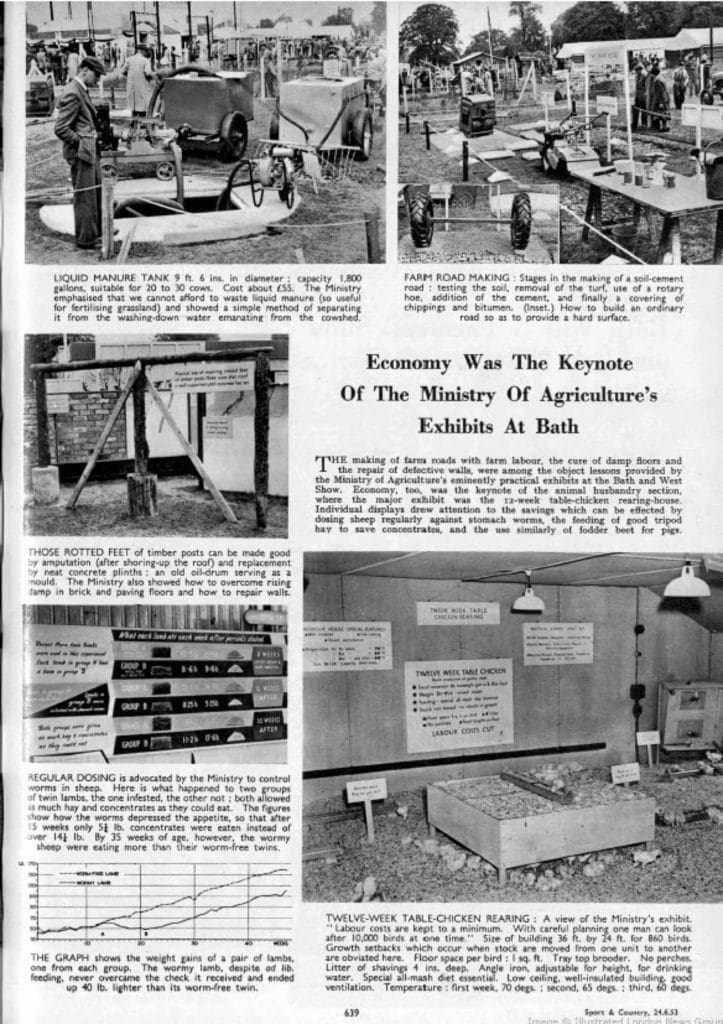
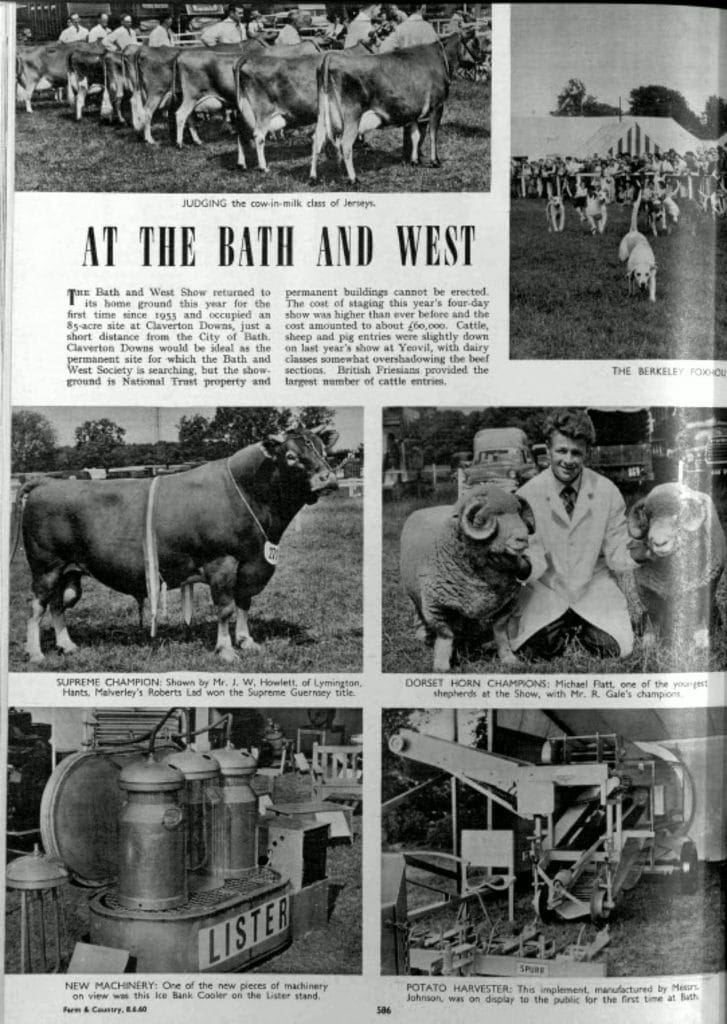
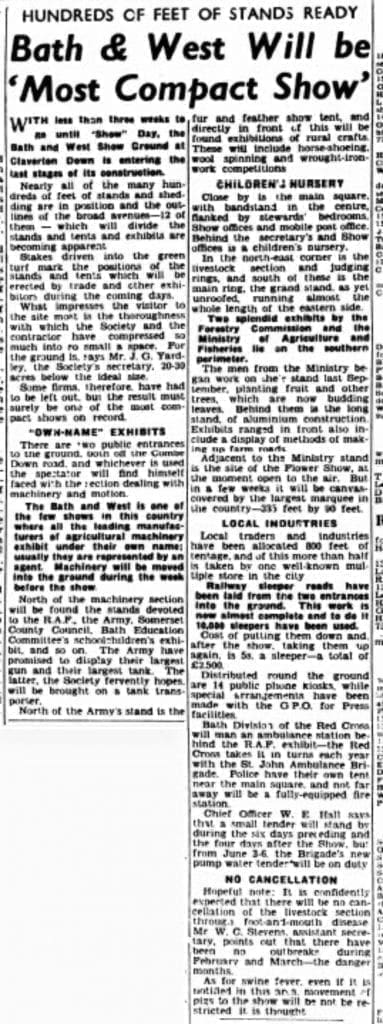
Street Numbering
Streets have often been named after a local landmark or person or something else that was memorable. Strange as it may seem to us, street numbering is a relatively recent innovation, though house names were created on much the same basis as street names.
The first known street numbers appeared in Paris in about 1513 on the Pont Notre-Dame. The houses all had identical facades so numbers were introduced to distinguish them.
The first recorded instance of street numbering in England is Prescot Street in Goodmans Fields in 1708.
A requirement that houses be numbered came with the Postage Act 1765. Even then the methodology was left to developers and occupants, who might not like the number 13, for example, which would lead – along with new buildings put up in gaps, the combining of streets and other developments – to things becoming quite muddled.
The Towns Improvement Clauses Act 1847 gave some powers to local authorities and the Metropolitan Management Act 1857 gave power to the Board of Works to control street names and numbers.[4]
The Public Health Act 1925 gave more powers and in 1957 Bathavon Rural District Council decided to renumber parts of Combe Down.
National Trust
The National Trust has over 500 acres on Combe Down, at Lyncombe and Widcombe, Claverton Down and Bathwick, the bulk being the 242 acres of Rainbow Wood farm.[5]
This was willed to the Trust in 1959 by Margaret Mary Mallett (1882 – 1959) of Longwood House (now the BMI Bath Clinic) who had promised to bequeath it to the National Trust in about 1931 or 1932.[6]
Members of her family, Margaret Elizabeth Snook Mallett (1905 – 1991), who was her daughter – her father had changed his name from Snook to Mallett – and Barbara Penelope Mallett Lock (1896 – 1978), who was her sister, later donated another 24 acres – Klondyke Copse and Fairy Wood – as well as 15 acres in Lyncombe and Widcombe and 66 acres at Bushey Norwood.
The National Trust also bought 125 acres in 1984 to help protect the Bath skyline where there is a circular walk of over 7.5 miles.[7]
The Mallett family were jewellers and silversmiths, who started at 36 Milsom Street in Bath in 1865. In the 1890s they took the lease of the Octagon Chapel in Milsom Street. They soon started dealing in antiques and in 1910 opened in London at 40 New Bond Street.
Mallet was described in the Draper’s Record of 26th December 1908 as:
“…the most sumptuous shop in Europe, the wares of which include practically priceless curios and treasures of historic association. Probably not under one roof may be found more millionaires in the course of a year than at Mallett's, in Bath, in the whole of the Kingdom.”
In 1937 the Bath business closed. In 2014 Mallett still trades in London and New York.[8]
In 1993 the Christian Brothers and Prior Park College gifted 28 acres of the lower grounds of Prior Park Gardens.[9]
On a personal note, the ashes of my father, Robert Eric Hill (1917 – 2011) were buried under an oak tree donated to Prior Park Gardens in 2011.
Other
Ralph Allen School
Ralph Allen School was built in 1957 and opened in 1958.
Church of Ss Peter and Paul

Between 1820 and 1837, Mass was said at Midford House, the home of the Parfitt family. From 1837 to 1901, the chapel at Midford Castle was used. Chaplains came from Downside Abbey (up to 1841) and then from Prior Park. The mission at Midford closed in 1901 when the house was sold. The parish was re-founded in 1919, using the chapel at Prior Park. In the post-war period, the development of housing estates in the area made the construction of a new church feasible. In 1954, the presbytery was acquired by the Diocese for £2,640.
The church was built in 1965 and opened by Canon Hughes on 17 September 1965. It was built in six months and cost £20,000. The architect was Martin Fisher and the contractors were F. J. Amery & Son. A planned spire or fleche was not built. The church was consecrated by Bishop Alexander on 1 June 1976.
The Beast of Brassknocker
Strange events began in July 1979. There were rumours that a monster was haunting Brassknocker Hill. Described as a fanged, four foot tall creature resembling a baboon, chimpanzee, spider-monkey, gibbon or lemur, the creature was of far more concern to some than it was to others.
Ron and Betty Harper believed that the creature had stripped whole sections of their old oak tree bare of bark. A month later, the number of trees stripped of bark had reached about fifty and the woods were plunged into an eerie silence after almost all the local birds fled the area.
81 year old resident Frank Green took a serious view of the strange situation. He started a day and night shotgun vigil, and told the media: “I am very fond of some animals, but I reckon this creature could be dangerous and I am taking no chances.” Fortunately he did not have the opportunity to shoot the beast. It avoided all of his attempts to track it down, much to the relief of the police, who not enamoured by the idea of an old age pensioner roaming around with a loaded shotgun.
It was seen by a man who was driving through the area late one night. He, anonymously, offered a description to the press that the animal he saw was a significant size, seemed a bit like a bear, briefly stood on its thick hind legs, and possessed a pair of large eyes that were surrounded by great white circles of fur or hair.
Getting in on the growing sensationalism, a Dutch newspaper – Het Binnenhof – ran a story that practically suggested an assault on Brassknocker Hill of the type of proportions one would expect to see in an attack by Godzilla! The title of Het Binnenhof’s article was: “Beast of Bath Destroys British Wood!” Its title guaranteed not just local and national interest, but international coverage too.
By the following summer, the mystery seemed to have been solved. Inspector Michael Price, saw what he thought was a large chimpanzee running around. The local press quickly sought comments from the police. “We were sure this mystery creature would turn out to be a monkey of some sort. After all, men from Mars aren’t hairy, are they?” said Inspector Price.
For the kids of Brassknocker Hill, however, the hunt for the beast provided them all a jolly adventure and it’s understood that several played tricks and pretended to be the beast.
Two years later, the stories returned, only this time were replaced by sightings of something very different. A stag, polecat, or even a Japanese deer, were among the many and varied candidates for the new beast of the hill. Then, one morning in the summer of 1984, reports started coming in to the news desk of the Bath Chronicle newspaper of a strange-looking creature holding up traffic on Brassknocker Hill.
Reporter Roger Green said: “I grabbed my notebook, Colin [Shepherd] the photographer grabbed his camera, and we rushed out to the hill. The reports were pretty credible, so we were convinced that there was something there. It was with slight trepidation that we entered the woods. After several minutes of stalking, we came across the ‘beast’ by then calmly grazing in a field. It was an Alpaca, a type of llama, and had escaped from a paddock. It was later reunited with its owner by the police.”
Quite obviously, this did not explain the earlier sightings. Needless to say, the mystery was never solved, and the best, if that is what it really was, vanished, died, or moved on to new pastures and tree bark.
Bath Clinic
The Bath Clinic comprises Longwood House and modern additions that were completed in 1983 to the designs of the Hospital Design Partnership by Marples Ridgway Property for Grand Met Services for Hospitals.[10]
Longwood House was built by John Francis W. Snook (1875 – 1947) (who changed his name to Mallett by deed poll [11]) around 1905.
Wessex Water
In 1997 Wessex Water bought 6¾ acres on the corner of Brassknocker Hill on a part of the site of the old Isolation Hospital. In February 1999 planning permission was granted.[12] Work started then and the building was completed in July 2000. The design is energy efficient and uses a steel frame and pre-cast concrete and clad in stone and glass. It has a floor area of 9,921 square metres.[13]
Combe Down Tunnel – Two Tunnels Greenway
Having been closed in 1967, the Combe Down tunnel reopened on 6th April 2013 as a shared use walking and cycling path. The idea gained approval in 2008 and the Two Tunnels scheme cost some £4.3 million.
Mulberry Park
In 2013 Curo purchased the 48 acre (19 hectare) Ministry of Defence site started by the Admiralty in Combe Down, for £50 million, intending to build about 700 houses on the site.
In August 2014 ITV‘s Bob Constantine reported on the demolition and redevelopment of the site.
Outline planning consent was secured in September 2014 and detailed planning consent for phase 1 was secured in March 2015. Construction started on site in Spring 2016.
Of the 700 homes 30% of the homes are to be affordable – 75% social rent, 25% shared ownership [14]. The 700 new homes range from 1 / 2 bedroomed apartments to 2 / 6 bedroomed houses, 277 are within the first phase. There are nearly £2 million of Section 106 contributions.
Examples of housing and prices include:
- Two bedroom semi-detached 775 sq ft house with 1 parking space and garden at £365,000 or £292,000 on help to buy
- Three bedroom 1,030 sq ft detached house with single garage and 1 parking space at £430,000 or £344,000 on help to buy
- Four bedroom 1,527 sq ft semi-detached house with 2 parking spaces at £550,000 or £440,000 on help to buy
The development also includes a new £10 million primary school with 210 places, children’s nursery and community hub. The school will open its doors for their first term in September 2018. Bristol-based Educate Together academy trust is the school’s official sponsor.
Foxhill masterplan
Somer Community Housing Trust (SCHT), which became Curo, was set up in 1999 following the Large Scale Voluntary Transfer of housing stock from Bath and North East Somerset Council (BANES). This included the Fox Hill Estate on Combe Down.
The government was keen to see such transfers take place because it was said to increase investment in improving housing without calling on public sector housing budgets or putting pressure on the public sector borrowing requirement. Moves could not take place without the backing of tenants in a ballot.
In 2009 a report commissioned by the Joseph Rowntree Foundation [15] concluded that:
"In their own terms, second generation transfer HAs have mainly recorded strong successes in their first few years of operation. One key unanticipated outcome has been the extent of their involvement in community regeneration. With most associations set up as transfer landlords continuing to exist as entities, it remains valid to speak of ‘transfer HAs’ and their ‘traditional’ counterparts. Over the medium and longer term, however, this distinction is likely to become less meaningful. As they mature further, some transfer HAs will morph into more diversified businesses or become absorbed within larger bodies, as they are likely to become increasingly attractive as partners in group structures or mergers. The challenge will be to retain and build on the dynamism and sense of purpose established in the initial phase after set-up. Both scenarios are also liable to result in diminished tenant representation at corporate level, though not necessarily a weakening of residents’ influence on landlords’ activities."
SCHT was joined in 2002 by Shape Housing Association (formerly Bath Self Help), a specialist provider of supported housing with around 150 bed spaces. Redland Housing Association, which was founded in 1973, joined in 2005, bringing with it a further 1,400 homes. In 2011, SCHT set up a single board and in 2012 began operating under a single name and brand – Curo and:
- Curo Places became the trading name of the housing association.
- Curo Choice became the trading name of the care and support business.
- Curo Enterprise became the trading name of the commercial business.
- Curo Response became the trading name of our direct labour organisation providing repairs and servicing.
In 2015 Curo Places converted to a Community Benefit Society under the Co-operative and Community Benefit Societies Act 2014 and was managing nearly 13,000 homes.
How ‘the masterplan’ for Foxhill developed
In 2010 ‘Bath and North East Somerset Joint Strategic Needs Assessment Indices of Multiple Deprivation 2010 Bath and North East Somerset Overview’ showed that BANES ranked 247 out of the 326 English local authorities, but that 5 LSOAs in BANES are in the most deprived 20% of the country. Foxhill North ranked 5,326 out of 32,482 being in the most deprived 20% for overall deprivation, income, employment, housing and services and the most deprived 10% for education & skills.
In April 2012 Professor Mark Hepworth, of Geoeconomics & Birkbeck College, University of London published a report on the Fox Hill Estate – Foxhill at the Crossroads. It said (inter-alia):
"The report is about a neighbourhood of Bath which visitors to the city are unlikely to see, the post-war council estate of Foxhill. Located on a hill a mile away from the city centre, the estate is one of the most disadvantaged communities in Bath and North East Somerset. The recession has hit people there hardest, and the life chances of children there are extremely poor by both national and Bath and North East Somerset standards. The problems of the Foxhill estate have persisted over decades. Apparently, this is because the community is too small, too much of an island, too hidden by the sea of prosperity around it and too lacking in social capital and community leadership. It seems that 'small is not beautiful' necessarily, and the regeneration of Foxhill estate is long overdue. If things continue as they are, people living on the estate will definitely not be part of the 'one great big sustainable community' the Council and its partners want to create by the year 2026. The compelling evidence presented in this report — the views of service managers, policy- makers and residents and the results of a detailed statistical assessment - show that the Foxhill estate has already been left behind and has all the potential to become a permanently excluded place — the antitheses of a 'sustainable community'. Is there likely to be a Cinderella twist to the Foxhill estate story? This scenario could become a reality if the estate benefits significantly from the redevelopment of the MOD site, literally right across the road.Informal planning guidance — called "Concept Statements" — has been prepared by BANES Council and developers, and public consultation on this guidance is now underway. Foxhill can be planned as one big sustainable community — a regenerated 700 home estate and a brand new 700 home estate, bridged by modern infrastructure, amenities and services. The report provides a shortlist of policy and concrete measures that could help to make Foxhill a sustainable community. This report should be widely read and acted upon by both Foxhill residents and other residents of Bath. Ultimately it must be taken forward by the Council and its partners who are responsible for ensuring that ideas like 'sustainable communities' and 'localism' are relevant to everyone. The report is not only about Foxhill, but also about BANES — is the 2026 vision described in the Sustainable Community Strategy really meant for everybody? The MoD redevelopment is the perfect opportunity to put this vision to the test."
The report also said that:
"Somer Housing Group should play a key role in producing a Foxhill Community Plan, given that 60 per cent of residents live in their accommodation, including the blocks of flats. According to Chris Boyes, Somer's Sustainable Communities Manager and formerly a BANES housing manager with responsibility for Foxhill, "we need to work with Foxhill from a community development perspective as well as a housing management perspective. And we need to work with the Council and other partners on the MoD site opportunity'."
In 2013 Curo purchased the 19 hectare former MoD site to redevelop the area, as Mulberry Park, with a mix of 700 houses of private and affordable housing. Of the 700 homes 30% of the homes are to be affordable – 75% social rent, 25% shared ownership.
In 2014 Ian Jones, Project Director for Curo told the Virtual Museum that Curo were looking towards devising a master plan for the whole of the Foxhill area and that would be after extensive consultation.
In 2014 BANES, with Curo’s support, applied for the Mulberry Park and Foxhill areas to be designated as a housing zone. In March 2015, Foxhill and Mulberry Park was designated as a housing zone by the government. BANES council could now bid for a share of £200 million for infrastructure and land remediation and access to cheaper borrowing from the Public Works Loan Board and priority access to expert planning and technical support from the Advisory Team for Large Applications Service (ATLAS) run by the Homes and Communities Agency.
In 2015 residents at Foxhill set up the Foxhill Residents Association.
In February 2016 a Final report prepared by Centre for Local Economic Strategies was presented to Curo entitled ‘SOCIAL AND ECONOMIC REGENERATION PLAN FOR FOXHILL & MULBERRY PARK’. One of the ‘overarching principles’ in it was:
Working in partnership with residents The social and economic regeneration of Foxhill is about the people of Foxhill. It is therefore essential that Foxhill’s residents play an active role in shaping and delivering social and economic interventions. The approach is therefore designed to be accessible and furthermore empower and capacity build the community to, in the long-term, take full control of their own social and economic destinies.
By March 2016 BANES & Curo published a Foxhill Regeneration and Development Charter, “as a clear statement of their shared ambitions towards creating a unified development linking Mulberry Park and the Foxhill Estate, which has wider benefits for the Combe Down area”. It was based on “three workshops organised by ATLAS and involving B&NES officers and members and Curo staff which took place over three months between November 2015 and January 2016.”
It stated the following ambitions for Foxhill:
- Communities: ‘communities which continue to be proud of themselves and the local neighbourhood’
- Connections: ‘a neighbourhood which is well connected and fully integrated with its surroundings’
- Housing Choice: ‘a destination where people choose to come to live and then want to stay’
- Quality of Place: ‘A vibrant neighbourhood with a mix of uses and a strong local economy’
It also stated:
"The redevelopment of the Mulberry Park site is seen as the ideal catalyst for major estate and community regeneration of Foxhill and was the key driver in Curo’s acquisition of the site in 2013. Curo owns approximately 60% of the 863 homes on the Foxhill Estate. Curo’s landholding interests in this area provide a unique opportunity to realise significant regeneration proposals for the existing estate alongside development proposals for the delivery of 700 new homes and associated facilities at Mulberry Park. The Charter seeks to describe this opportunity for new investment in the neighbourhood, stimulated and secured through the redevelopment of Mulberry Park. It describes a series of ambitions and the collaborative approach to their delivery in order to realise the benefits in terms of the broader economic, housing, social, education and cultural offer within Combe Down."
In June, July and September 2016 Curo held ‘public exhibitions’ for the Foxhill Estate with the objective of submitting “an outline planning application for Foxhill estate.”
The exhibitions stated that:
"Curo is working to develop a masterplan for the regeneration of the Foxhill estate, building on the ambitions of the Foxhill Regeneration and Development Charter. This masterplan will then be refined to form an outline planning application to Bath & North East Somerset Council ... Curo's proposals for the regeneration of Foxhill could affect existing tenants and homeowners living on the estate. we understand that this may be an unsettling time for you. We are here to support you through every stage of the process ... The illustrative masterplan for Foxhill estate will be developed using the ambitions of the Foxhill Regeneration and Development Charter as guiding principles to the process ... The wider neighbourhood surrounding Foxhill estate is being considered in the development of the illustrative masterplan to create an integrated proposal that responds to the surrounding context ... The proposals for Foxhill could provide around 600 new homes in a mix of 1 & 2 bed apartments, mews houses, terraced houses, town houses and semi-detached houses — ranging from 2 to 4 bedrooms ... At least 30% of new homes will be affordable housing and up to 70% market sale."
Planning application
An outline planning application was submitted in November 2016. It included the “demolition of up to 542 homes“. Of these 414 were classed as affordable and let below market rates by Curo or a different housing association. About 72 were privately owned. Curo proposed to replace the 542 homes with 700 new dwellings of which 210 would be classed as affordable, a nett loss of 204 affordable homes at Foxhill.
Curo stated:
"The delivery of private market housing and a more diverse housing mix will break down perception barriers within the local area ... across Foxhill and Mulberry Park a total of 420 new affordable homes will be provided ... thus there will be a net gain in the number of affordable homes.".
BANES planning services team deemed the application:
"not acceptable in the current form ... The loss of affordable housing is in conflict with the requirement for the Council to meet its objectively assessed need for housing as set out in the Core Strategy ... There is an overall net loss of affordable housing, and this needs to be justified against the regeneration benefits that the scheme is designed to achieve."
By July 2017 however, despite more than 250 objections on the BANES planning portal, the application was tipped for approval by the council’s Development Management Committee.
Curo said:
"We’ve made a number of changes to our initial proposals, taking into account as much feedback as we could ... The end result is an application which falls within B&NES published policy, while delivering the vision set out in the regeneration charter that has been adopted by BANES ... We’re pleased that the planning officer has recommended our application for approval, balancing a range of factors to reach his objective assessment".
Foxhill Residents Association, which represents tenants and owner-occupiers, said that:
"... people will be forced out of their homes and that some won’t be able to afford to live in the area or will have to move into something much smaller at Mulberry Park."
Sylvia Morris, who lived on the estate for 48 years, said:
“I feel very sad to think that people are going to be turned out of houses which are quite a medium size for families, with children, to be put into smaller accommodation ... I also feel that now, the rents are that expensive that when they put people out of properties and they go into other properties, they have no money to pay for them. There is no money ... A council estate at the beginning was for poor people that had hardly any money, but now it’s all 'right to buy' and in houses that people have absolutely no money to pay for them and I cannot see what the answer is here at all".
Nola Edwards, chair of the Foxhill Residents Association, said that residents had been fighting Curo’s plans for three years but that:
“... nothing we have put forward has been adopted ... We’re not opposed to change. We just don’t want our homes demolished ... Curo thinks it’s okay because more social homes are being built at Mulberry Park ... But this is our community and our estate and we don’t want them destroyed.”
She also wrote an open letter that was published on Bath Newseum she said:
"The Department for Communities and Local Government presides over the Estate Regeneration National Strategy and Curo includes the following quote in their submission to BANES planning department. The Government is committed to the regeneration of its post war housing estates. In an article published by DCLG (10 January 2016), it is stated: As we tackle this problem, we should learn the lessons from the failed attempts to regenerate estates in the past. A raft of pointless planning rules, local politics and tenants concerns about whether regeneration would be done fairly all prevented progress* Curo have not failed in heeding this observation. Tenants and homeowners concerns about fairness have been totally disregarded. The plans for the regeneration of Foxhill have followed a pattern perfected by developers specialising in estate replacement. Common themes are: the landlord cuts back on routine maintenance, a practice known as managed decline. Reports are commissioned portraying the area for redevelopment in the worst possible light and then heavily relied upon to justify demolition. A consultation takes place but questions are posed in ways that give the developers the responses they seek. The developer attempts to engineer local engagement in a way that stifles opposition from local people. This has been the experience of the residents of Foxhill. When Curo purchased the MoD site adjoining our estate locals paid little attention to how Curo might develop it. So when many of us attended an exhibition in April 2014 to see what the extension to our estate would look like we were appalled with what we saw. This was the first time that the majority of us found out about the proposed regeneration. We were presented with a fait accompli 542 of our homes simply did not exist in the illustrations. Many of us were shocked and immediately sought answers from Curo and BANES. Individuals struggled to make sense of what was happening. Homeowners and tenants alike were bewildered and didn’t know where to turn. Foxhill residents consider themselves to have been tricked; a questionnaire which we believed to be about the MoD site had been used to justify the destruction of our estate. Fortunately for Foxhill, one individual helped us find our collective voice. During the 2015 general election, Mike Arkell was campaigning on the estate, he was so upset by what he was hearing on the doorstep that he set about making a difference. Thanks to the tireless efforts of Mike and his wife Siobhan Foxhill Resident’s Association was founded. FRA has been engaged with both Curo and BANES since 2015, we have campaigned tirelessly to change Curo’s proposals. We want to see investment to revitalise our existing estate through a programme of planned maintenance, renovation and where there is agreement with those directly affected some replacement of housing stock. None of our objections have resulted in a softening of Curo’s approach. ... There is a strong community in Foxhill, many tenants have lived in their homes for decades and the properties that have been bought under the right to buy scheme are mostly occupied by the people who originally rented them. There are 95 homeowners in the regeneration zone and they all live in fear of compulsory purchase orders. Curo make much of offering market value plus 10% to acquire their homes, in reality, this would leave homeowners at least £100,000 short of the funds to buy a new property in Foxhill. The alternative on offer is shared ownership in a new build. I like all the other homeowners I know wouldn’t swap my home at any price; we simply dislike the high-density development that we can see being built on our doorstep".
On July 26 2017 BANES Development Management Committee approved the outline planning application by 5 votes to 4. This was despite the opposition of both Combe Down ward councillors and Bath’s MP.
Foxhill residents fight on
Foxhill residents set up a crowdfunding page to mount a legal challenge via a Judicial Review. They also used Facebook and Twitter extensively to engage public opinion and made a moving film about their case.
Councillor Tim Warren, BANES council leader later stated he would not sanction any mass compulsory purchase orders for the site.
By March 2018 Curo backed down. Victor da Cunha, Curo Chief Executive, said:
"We have reluctantly taken the difficult decision to change our approach to regeneration at Foxhill. We will no longer consider demolition of homes on the Foxhill estate, either privately owned or belonging to Curo. “Instead, we will work in partnership with local residents to create a new plan, focussed on significant investment in the refurbishment of existing Curo-owned homes over the next few years. This will help give certainty to residents and deliver improvements to homes in Foxhill more quickly. As you may know, Curo – a housing association with charitable status - bought the Ministry of Defence land at Foxhill in 2013 because of the opportunity it offered to bring investment and lasting improvements to the Foxhill estate for the benefit of its residents. We worked with BANES Council and local residents to develop a shared ambition for the new homes, improved connections and greater opportunities that could be created. However, since 2013, many things have changed. We were clear from the start that to deliver high quality new homes and sufficient affordable homes through large-scale regeneration on the Foxhill estate we needed three things: community support, political support and government funding to increase the number of social rented homes proposed. We’ve been working with and listening to the local community over the last five years. It’s clear that there is some opposition to the demolition of homes and to the loss of social housing that redevelopment would inevitably entail. We have received varying levels of political support and we have received no clear decision about grant funding from central government. Residents have told us that they no longer want to live with the uncertainty of what may happen to their home in the future. The recent legal action by a group of residents may result in further delays and uncertainty for twelve months or more. Even if this legal action is unsuccessful, this would not promote the necessary consensus to deliver a truly community-owned, successful project.”
Despite this residents decided to proceed to court after learning there was no legal guarantee their homes were safe from demolition.
Nola Edwards, chair of the Foxhill Residents Association, said:
"Despite residents writing to Curo asking them for a legally binding promise not to implement the planning permission and asking Bath Council to quash the permission neither have been willing to agree to these requests. Without that assurance there will be a nagging doubt in the minds of residents that the current state of affairs is a temporary reprieve and not an end to the threat of demolition and the associated stress and anxiety that accompany it."
The Judicial Review took place in May 2018. On June 20 2018 Mr Justice Lewis, quashed the planning application. He ruled:
"In the present case, there is no evidence at all that the defendant had due regard as required by section 149(3) (a) and (b) [of the equality act] to have due regard to the need to remove or minimise disadvantages suffered by persons who share a relevant protected characteristic or to take steps to meet the needs of such persons The relevant characteristics were age, disability, race and pregnancy or maternity ... The grant of outline planning permission on 30 November 2017 was unlawful, and that outline planning permission will be quashed.”
After the news that the Foxhill residents had won their case, Nola Edwards of the Foxhill Residents Association said:
“After four years of battling, residents of Foxhill can finally breathe a sigh of relief. We're all delighted. Our homes are safe, our community's safe, and it's thanks to the support we've had from all over Bath. We couldn't ask for more today. And I'd just like to say, BANES Council, you need to think about how you take these decisions. It's not just bricks and mortar, it's people's lives. You need to use your heart as well as your head."
Cable car plan
Cable car plan
At 16.02 on a Tweet appeared for a Twitter account A Cable Car for Bath. The account specifically stated: “Account not run by Curo Group”. This was one of the first indications of a plan by Curo, the housing association that was previously Somer Community Housing Trust and responsible for building the new estate of Mulberry Park on Combe Down as well as the Foxhill masterplan on Combe Down to build an Aerial Tramway or Cable Car.
The account started tweeting, inter alia, about difficult school runs, Bath’s traffic problems and how cable cars could be a tourist attraction as well as solving traffic problems.
By 2017 it became clearer what the proposal was. There were to be two terminals, one near the train station and one at Mulberry Park and 2 large gondolas to carry up to 60 passengers and bicycles each. It was stated that the fares would be lower than existing bus fares.
In March 2017 Victor da Cunha, Curo chief executive, published an article entitled: “Why a cable car is right for Bath“. This stated, inter alia:
..."We believe a new, affordable transport connection like this could improve the lives of people living and working in the south side of Bath and beyond. It could transport them to college, to shops, to cultural and social events, to their job, whether that’s in the new enterprise area at Bath Quays or further afield via connections by train or bus. From the city centre, a cable car could also move kids to school, students to the university and employees to their place of work at the top of the hill. It’s a truly sustainable, ultra-low emission form of transport. In this first consultation, we want to see if people agree with the principle. If we get a positive response from the City, then we will move to the next stage in the autumn, consulting on the details of the project, including the suggested route, design, fare structure and so on. We don’t intend to run the cable car – that’s for a transport operator to do. However we do think a cable car is a forward-thinking idea that could support the city’s economy and help address the increasing demands on road infrastructure."...
Transition Bath summed up their views of the pros and cons at the end of March:
Pros
- would provide a boost to Bath tourism (and is supported by the business community)
- claimed to have a lower fare than the current buses
- a much faster journey time of 3 to 6 minutes
- have space for bicycles – supporting multi-modal, sustainable transport options
- will probably provide an uplift to home values in the new Mulberry Park estate, and for existing homes in Foxhill and Combe Down
- more sustainable as zero local pollution, and lower overall CO2 emissions compared with public transport alternatives
- relatively low visual impact (2 x cables, terminals, a few towers plus 2 x gondolas)
Cons
- the main opposition seems to be from residents of Widcombe who are worried about privacy – the exact route, locations of cables, towers and terminals are not published yet
- others are worried about the visual impact on Bath’s World Heritage site and the green belt to the south
- it may reduce the economic viability of existing bus services – although the viability may increase with more passengers on the south side of path opting to take the bus to the Mulberry Park terminal as a way of getting into town?
The Widcombe Association was one of the leading opponents. Their objections were summed up thus:
“They won’t reveal the precise route, but a straight line from Foxhill to the city centre goes over Perrymead and Lyncombe Vale, over Greenway Lane, close to Lyncombe Hill and Alexandra Park, down Beechen Cliff and over or close to Alexandra Road, Southcot Place and St Marks Road – as well as potentially over two schools.
It will scar the landscape and be visible from all over Bath city centre.
- What do we know? Curo’s consultants, Arup, have said that the cars would each hold 80 – 120 people and be the size of a bus, and there would be a docking station at each end and two towers along the line. These would have to be very tall, and on the highest points of the route, to support the weight and the span.
- What will it cost? No-one knows but the Emirates Line in London’s Docklands cost £60m. Passenger numbers have dropped and the Daily Mail called it ‘arguably the most pointless piece of public transport in the country’.
- Surely they won’t get planning permission? They’re intending to bypass the usual planning system and go straight to the Secretary of State for Transport.
- Do Foxhill residents want this? No. They’re already fighting Curo, who want to knock down their homes and reduce the numbers of social homes for rent.
- The impact on the Green Belt and Bath Conservation Area would be devastating, and another threat to the city’s World Heritage status.
They’re spending ££££s pushing it as a transport solution for south Bath. But the reality is they want it to help them sell houses at Mulberry Park, their new housing development, and to re-develop Foxhill estate against the wishes of the residents. They’ve even suggested that it could be the start of a citywide network – so where next? Bathwick Hill, Lansdown, Weston or Lambridge? Great for developers – but not for Bath!”
They wrote a strong letter of objection to councillors.
By July 2017 Curo had abandoned the idea after after negative feedback during the consultation process.
Of almost 3,000 responses to a survey the principle of a cable car was not supported by the majority of respondents, with 55% of people stating they did not back the idea. When asked ‘In principle, do you support the idea of a cable car for south Bath?’ 45% of respondents were either supportive or wanted more details in order to make a decision. Residents of Widcombe submitted the highest level of responses, 21%, with 86% of Widcombe residents saying they did not agree with the idea as a matter of principle. Across the rest of the city, the overall opinion was more balanced, with 54% either in support or undecided and 46% not in favour of the principle.
The Widcombe Association said:
"Widcombe residents were overwhelming against these proposals because it was simply the wrong scheme in the wrong place. We believed that it did not address the City’s traffic problems but it would have been intrusive in the world heritage and green belt setting and would have had an unreasonable impact on residents without any real benefit to the City to offset this. In short the proposals were neither beautiful nor inventive. We were also doubtful that the scheme was financially viable without massive tourist uptake, but we will never know."
It wasn’t really a new idea anyway.
